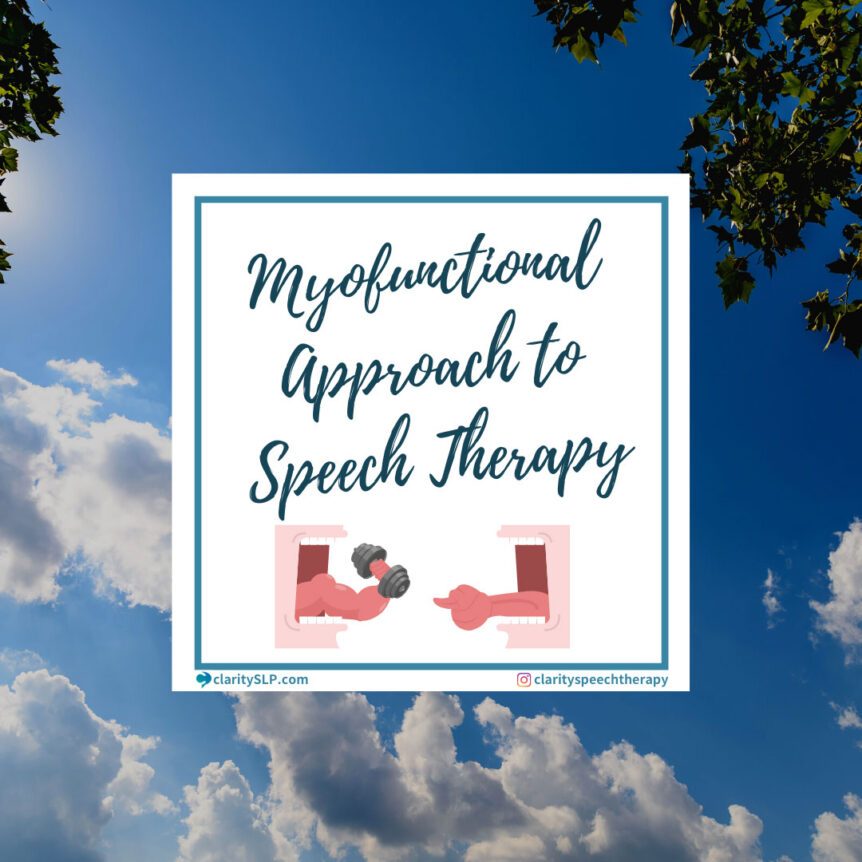If you were referred for orofacial myofunctional therapy, you were likely sent by your dentist, surgeon, or sleep specialist. They had concerns that your resting tongue posture or swallowing pattern may be a factor, but how is this related to speech therapy?
Orofacial Myofunctional therapy is an approach to therapy looking holistically at the client, ensuring ideal airway health at the foundation. For Clarity Speech Therapy, this means completing a comprehensive case history and in-depth assessment of the muscles of the orofacial complex (i.e., the muscles of the mouth and face). We will then work together to rule out any airway concerns (which may include referrals to other specialists due to concerns such as enlarged tonsils or adenoids, allergies, high arched palate, tongue tie, or others).
Orofacial myofunctional disorders commonly result in atypical or maladaptive swallowing patterns (often called tongue thrusts), inefficient chewing, mouth breathing, low and or forward tongue resting posture, speech sound disorders (such as “R,” “S and “Z” or “SH,” “CH,” and “J"), and temporomandibular joint (TMJ) dysfunction (TMD) or TMJ pain due to chronic clenching and grinding.
Together, we will work on setting up healthy habits!
Resting Posture of the Tongue
The ideal place for the tongue is up, gently suctioned to the roof of the mouth. The tip of the tongue should be just behind the teeth (in the same place we make the “T,” “D,” or “N” sounds).
If your tongue is low or forward it will place pressure on the teeth, which may cause atypical jaw growth or the pressure may push the teeth (creating an open bite).
When the tongue is low in the mouth, you may see concerns regarding oral habits such as thumb sucking. Sometimes simply establishing ideal tongue posture can reduce these persistent habits.

Resting Posture of the Lips & Nasal Breathing
The ideal posture of the lips is closed, allowing us to breathe through our noses 96% of the time or more.
When the lips are open due to oral weakness, allergies, or other issues. We see an increase in acid reflux, drooling, and illness (as the nose is no longer filtering the air we breathe). We also see changes in the chewing pattern during oral breathing; this, in turn, may cause a delayed eruption of teeth or persistent open bites.
Once we rule out any causes, we strengthen the lips and establish healthy nasal breathing.
Orofacial Myofunctional Disorders & Sleep
The same muscles that we use to eat and for oral resting posture also comprise our airway. If you suffer from sleep disordered breathing such as Obstructive Sleep Apnea (OSA) or Upper Airway Resistance Syndrome (UARS) there may be weakness in these muscles. There are multiple treatments for OSA and UARS, please consult with your sleep specialist. Myofunctional therapy may be an adjunct treatment.
OSA occurs when there are obstructions in your airway during sleep, possibly caused by the throat muscles relaxing and blocking your airway during sleep. In therapy, we strengthen the muscles of the oropharyngeal complex and establish healthy oral resting postures. For example, it may be that the tongue is falling into the airway during sleep. Together we can rule out conditions which may cause the tongue to lay low in the mouth (e.g., tongue-tie, allergies), strengthen the tongue, and train the tongue to suction to the roof of the mouth naturally throughout the night.
UARS is another common sleep breathing disorder resulting from a slowing or blockage of air during sleep. People with UARS often wake up during the night and report significant daytime fatigue. Commonly, they will present with a high arched palate, nasal allergies, and laryngopharyngeal reflux (“silent reflux”), which creates inflammation in the tissues of the nasal airway. The palate is the roof of your mouth, but also the floor of your nose. Any blockage or inflammation of the nose will cause you to breathe through your mouth, dropping your tongue down into an oral breathing pattern. We will work together with your orthodontist during or after palatal expansion to help you establish healthy oral resting habits.

Oral Function & Picky Eating
Imagine that you took a sip of soda, and your best friend said something hilarious; you may have just sprayed that soda out of your nose. It felt disgusting, right! Livable if it happens once or twice in your life, but what if a tiny amount of soda went up your nose every single time you had a sip. It wouldn’t be long before you would stop wanting soda altogether. You may get to the point where you saw a can of soda, and you would push it away.
Some of our “picky eaters” actually have problems with the muscles of swallowing, moving up into their nose (nasal regurgitation), causing food to fall back into their throat before they are ready (premature spillage), creating a fear of choking or for others the food doesn’t clear and feels like it is stuck (globus sensation). These kids then stop eating specific foods or entire classes of foods (e.g., mushy food, chewy food, bitter vegetables) because they are hard to eat. This can become so challenging that it may even evoke a fear response. We can work on the function of the swallow to make sure the kids and adults are safe eaters. Then if needed, we can collaborate with your feeding therapist to ensure that they are on the ideal textures for them.
If there is an oral breathing pattern, chewing can be impacted. Some kids will over chew their food and meal times will take excessively long times. Others will not chew their food sufficiently or swallow air during chewing and may report stomach upset. Therapy needs to be functional, and chewing is one if my favorite therapy activities!
At Clarity Speech Therapy, we will discuss selective feeding patterns and parent education may be provided; however, we do not offer therapy specific to selective feeding alone. If your concerns are isolated to diet limitations, I encourage you to work with a clinic who is specialized in pediatric feeding. Feeding Matters has an excellent screening tool to help inform your conversation with your primary care provider. https://questionnaire.feedingmatters.org/
Oral Function & Breastfeeding
Many clients with orofacial myofunctional disorders presented with difficulty breast/chest feeding as an infant. Feedings may have been painful or with a shallow latch, extended nursing time or short times between feedings. There are times when exclusive breast/chest feeding is not possible. Know that Clarity is a no judgment zone!
At Clarity Speech Therapy, we will ask about early feeding as part of the case history, but we do not offer lactation support or infant therapy at this time.

Oral Function & Speech
There can be many causes for a speech delay, but the function of the muscles may be one of them. If the tongue is positioned too far forward in the mouth at rest, or there is weakness for tongue retraction, then the tongue will make contact with the teeth during speech, resulting in a “lisp.” If there is inadequate strength or range of movement in the tongue, then creating enough tension for other sounds may be challenging. For others still, breathing discoordination may be the fundamental problem. Each sound may be produced accurately, but speech may sound mumbled and quiet.
A full assessment will guide treatment.
If your child has no functional or muscular concerns, you will be referred out to a local general speech therapy practice. However, persistent speech disorders (those that don’t resolve quickly to traditional speech therapy) may have a structural or underlying muscular component.
Let’s work together to set your child up for successful clear speech.
Why a Speech Therapist?
Speech-language pathologists, commonly called speech therapists, are the rehabilitation experts from the diaphragm up: working on breathing, speaking, and swallowing. Sounds familiar now, doesn’t it?
I bring in evidence-based practice from dysphagia (swallowing disorders), feeding therapy, voice therapy, and of course, speech therapy to ensure that each client can achieve their best!
That said, it is a team effort! I could never do this alone, and if needed I will refer out to occupational and physical therapists, massage therapists, orthodontists, allergists, sleep specialists, gastroenterologists, otolaryngologists, or others.
Check out the FAQ and research section for more and the following open access family-friendly article by speech therapist Linda D’Onofrio regarding how oral dysfunction causes malocclusions.


Comments 2
What CPT code would a speech therapist use for evaluation and treatment using myofunctional therapy approach with clients with obstructive sleep apnea?
Thanks for asking! The CPT code will reflect the disorder being treated, most commonly the speech or swallowing disorder. The most common CPT codes in my practice are 92610, 92522, 92526, and 92507